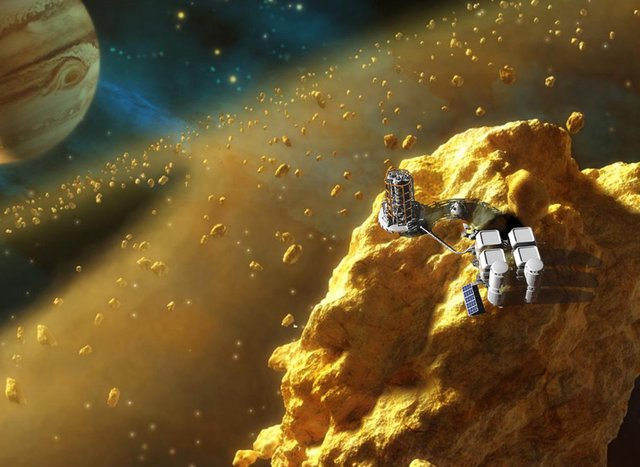
A man discovers an asteroid containing $1 trillion dollars worth of gold, he spends a year and hundreds of millions of dollars to convert this raw gold into gold coins. He wishes to use this gold to bootstrap a new gold coin currency, but is faced with the challenge of distributing these gold coins to the masses. As a rational actor, this man also wants to maximize his own profits so that he can reinvest in things that create more global demand for gold. Any profits he leaves on the table will accrue to someone else as the free market and voluntary exchange work their magic. It is unknown if these other people will be as effective at reinvesting the profits to drive gold demand.
Dividing up the Profits
There are several different types of people who could profit from this man’s effort:
Those who found the asteroid, mined and then minted the coins
Those who did nothing but watch
Those who buy coins and then sell them for more
Assuming those who mined and minted the coins sell at market established prices, those who buy and sell for more have earned their profit by taking on risk. If those who mined and minted the coins sell below the market price then those who buy below market price and sell at market price take no risk and therefore earn profits for doing nothing. By selling below market prices profits go to those who were fastest to claim the limited supply and free profits for doing nothing (but being fast).
Distribution Strategies
The man realizes he needs a plan to maximize his profits or someone else will, so he considers his options.
Keep It
Under this option the man can sell his gold coins a little at a time, but because he has cornered the market in gold no one wants to adopt it as a currency. As a result he is only able to realize a small portion of his gold’s value and a gold coin standard is never adopted. In addition he has no capital to invest in businesses that drive gold demand.Give it all away
Under this option the man gives the coins away to everyone, but no one has any incentive to see the gold coins adopted as a currency, so almost everyone sells the coins to buy a single meal. A savvy banker buys up the gold coins at cheap prices and then sets about a plan to turn them into a new currency.
If he gave it away to a single individual then the problem simply moves from the original man to the new owner. If he wants to give it away to everyone, then he must implement a system to prevent the same person from requesting multiple coins.
In any event giving the coins away does not generate capital to invest in businesses that drive demand for gold coins.Sell it for a fixed price
The man could decide to sell it all, but he doesn’t know what price to set. If he sets the price too high then no one buys it or it sells very slowly. If he sets the price too low then a savvy banker will buy it all up at once before anyone else can discover the opportunity. Either way, the man fails to achieve his objective and the new buyer gets to come up with a better distribution model and key the profits.Auction It All
Under this model the man sets up an auction to sell it all, but no one has enough money to buy it all so the highest bidder ends up being the wealthiest individual who gets it all. This individual is then in the position to make a profit by monopolizing the market.Multiple Item Auction
Under this model bids are accepted from all and the highest bids are filled first until there are no more coins left. Everyone pays the price of the lowest bidder. Each person has to choose between bidding for more coins at a lower price or for fewer coins at a higher price. If they bid too low they may get nothing, but if they bid too high they may get less than they desire.
This particular option has the benefit that the buyers have control over the price, everyone gets the same price, and that price is the lowest price that is still high enough to qualify. Unfortunately, it means that some buyers don’t get anything and that the seller is leaving money on the table for every buyer willing to pay more than the lowest bid.
This approach also dumps it all on the market in a short period of time. There is much less capital available over a short window of time than over longer windows of time. To maximize the profits this type of auction could be repeated daily over a year or more.Give Share proportional to Money Paid
Under this model everyone who would like gold coins puts money into a pool. Everyone gets a number of coins proportional to the money they put in. Everyone gets the same price; however, no one knows what the price is until all the money is received. This forces everyone to estimate how much money everyone else will put in. If you think everyone else will put in too much money, then don’t put your money in. If you think everyone else will not put in enough you put in money. You can choose whether you want to reveal your estimate by putting money in early, or you can wait and put it in a the last second. Either way the total is unknown to everyone until the last second.
This model also forces those with the most money to put their money in first or else they will be forced to bid the price up or not participate if the price would go above market value. Those with less money can play the margins by deciding if they want to buy small amounts at higher prices than the large holders were willing to pay.
This approach also suffers if it is done over a short window of time, so for maximum effect the man divides his coins into 365 lots and sells them over a year.Commit to selling on Open Market over Time
Under this model the man informs the world that every minute for the next year he will sell a coin until all coins are gone. He will sell this coin to the highest bidder in a traditional exchange order book.
This model works like the multiple item auction except it spreads it out over time rather than selling it all at once. It also ensures that the man gets the highest prices from the order book rather than the lowest. In this way the man sells his gold to the highest bidder and dollar cost averages his sale to maximize his returns and minimize his risk.
Implementation
The man considers his options and decides that it would be best if he distributed the coins in a fair and transparent manner using a smart contract on a public blockchain. This way everyone can trust the distribution process and he can maximize the value of his coins by reducing risk.
He evaluates the market and concludes there is only a single smart contract platform that has sufficient liquidity and financial connections to sell his coins. He hires an expert on this platform and asks him to implement option 7, selling one token every minute to an open order book. The expert informs him that the smart contract platform is not capable of implementing this algorithm because the cost of “gas” would be unpredictable and there is no easy, cost effective, way to maintain a sorted order book.
Saddened by this reality, the man considers option 6. While slightly less than ideal, it will generate market pricing and 3rd parties can take the risk of buying from the smart contract and reselling on centralized exchanges. In this case those who perform arbitrage are providing value that the smart contract platform could not perform. In exchange they earn a small commission based upon the arbitrage opportunity.
Conclusion
The man with the asteroid has an asset whose efficacy is maximized only when it is well distributed. As a rational actor he should attempt to maximize his own wealth by ensuring his coins adopt monetary value in addition to their gold value. This means he will need a strategy to ensure the market trusts the distribution process and that he profits from it. He also needs a strategy that ensures no one gets something they didn’t earn...
Listen to last week's Hangout Here!
And during the Week you can find us in Our 24/7 WhaleShares Server! (preferably the Adult Swim VOIP)

All BeyondBitcoin content is powered by Steemit.com so please join the new social media movement that enables Creative Commons content creators and Open Source developers to earn funding for participating in the community's growth and sustenance. Post to Steemit.com to earn and pay others with a simple upvote!
Hi! I am a robot. I just upvoted you! I found similar content that readers might be interested in:
https://steemit.com/eos/@officialfuzzy/how-should-one-distribute-a-usd1-trillion-dollar-treasure
Downvoting a post can decrease pending rewards and make it less visible. Common reasons:
Submit